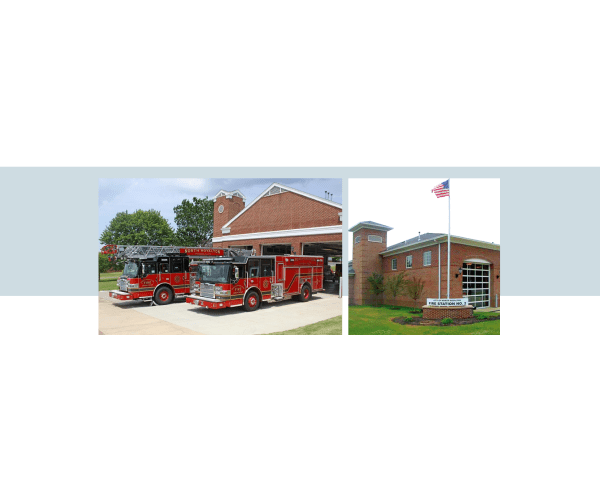
North Royalton Fire Department: Improved Communications
North Royalton Fire Department: Improved Communications

Challenge
North Royalton, Ohio, an upscale Cleveland suburb of 30,000, built a new 6,000 square foot residential neighborhood satellite fire and emergency medical services station in addition to remodeling its downtown station headquarters. As part of the process, the fire department sought to improve its communications system to address a number of issues, including station-to-station paging and paging clarity.
The North Royalton Fire Department (NRFD) faced a number of paging challenges, including the inability to prioritize between high priority 911 calls and low priority local calls. Often calls from various sources with varying priorities would come in simultaneously and paging signals going to different speakers would create confusion, resulting in delayed response times by firefighters or EMTs. In addition, many pages were virtually inaudible. Concrete, glass, and drywall construction in both locations created smooth, hard surfaces that enhanced reverb and ambient noise was problematic when doors were open. Compounding the problem was the inability of the dispatcher to page between both station locations. “Eighty-five percent of our emergency calls are for EMS services,” stated Fire Chief Mike Fabish. “Some citizens who are experiencing trauma or severe heart or breathing problems need help to arrive as soon as possible – there’s no time to lose.”
- Enable all-call paging between two fire stations
- Create an audio system to provide clear, intelligible paging
- Reduce dispatch and response time for firefighters and EMTs
- Broadcast dispatches from squad cars and fire trucks into fire stations
As a result, Fabish called on DBS Communications of Brook Park, OH to address its communications challenges for the main fire station (Station 1) and the new residential satellite station (Station 2). DBS immediately turned to Bogen for assistance in recommending and designing an audio system to meet all the needs of the growing department.
“I selected Bogen because of my positive personal experience with Bogen products, people, and pricing,” commented Dave Schremback, president of DBS Communications. Working closely with one of Bogen’s regional sales managers, Schremback chose the Bogen V100 Power Vector Amplifier as the backbone for the paging systems in both stations.
The V100 is ideal for prioritizing inputs. It features eight bays for input modules that accept a variety of sources and can be set with four levels of priority between modules. With the V100 Power Vector Amplifier as the key system component for prioritizing and routing pages, DBS and Bogen tackled the challenge of designing the individual systems for Stations 1 and 2.
The NRFD’s two new Bogen communications systems have dramatically improved the fire department’s ability to prioritize, route, and respond to both emergency and routine calls. Connected through a high-bandwidth T1 phone line, the two stations can now seamlessly and selectively page both locally and station-to-station. Bogen speaker technology provides the department with dynamic, accurate, undistorted sound so that previously inaudible, confusing pages can now be clearly and immediately understood, improving emergency response time.
“Bogen products have really helped us,” observed Chief Fabish, noting that improved emergency response time means improved public safety. “Bogen’s regional sales manager has done a good job helping us get the right products for this installation,” added Schrembeck. “I’m convinced that no other single audio product would do what a Power Vector Amplifier would do.”
Station 1
Located in downtown North Royalton and operating as the main fire station, Station 1 was built decades ago and used a communications system based on a phone switch located in city hall. To provide the system with more power, flexibility, and versatility, DBS Communications installed a V100 Power Vector Amplifier in the station and used the advanced input modules to assign the highest priority to 911 dispatch calls, second priority to remote calls, and lowest priority to local calls. Local page access was handled by lines from the telephone switch routed through a Bogen Telephone Access Module (TAMB) which enabled the phone system audio to be distributed across the paging system. The TAMB was connected through a Bogen Transformer Balanced Input Module (TBL1S) installed in the Power Vector Amplifier with an additional input enabling pages to be received from Station 2. A third input through a Mono Auxiliary Input Module (MAX1R) into the V100 received signals from 911 dispatch as well as squad cars and fire trucks.
To create audible, intelligible pages throughout the higher noise areas of Station 1, DBS installed 3 Bogen NEAR® A-Series Loudspeakers (A2T) which provide superior clarity. “We installed the A2T speakers because the increase in noise when the doors are open required speakers to produce pages higher than 80 decibels,” commented Schremback. In addition to the A2T speakers, DBS also installed three Bogen Ceiling Speakers (S86T725PG8W) to provide appropriate paging levels in quieter office areas.
Station 2
Despite being a new building designed to provide enhanced services to the residential neighborhood it serves, Station 2 was originally equipped with a very basic communications system featuring four horn speakers in the truck bays and maintenance areas, three ceiling speakers, two wall phones, and some amplifiers. Operating in a relatively small, enclosed area, the horn speakers generated quite a bit of reverb, making it virtually impossible to understand pages. Following Bogen’s advice, DBS replaced the original horn speakers with 3 Bogen A2T speakers. Mounted eight feet from the floor and 40 feet apart, the A2T speakers were pointed horizontally across the truck bays to maximize the listening space and minimize distortion, virtually eliminating the reverb problem. Three existing Bogen Ceiling Speakers (S86T725PG8W) were augmented with 3 additional ones to ensure that pages reached every corner of quieter common areas such as offices, hallways, and the lunchroom.
As in Station 1, a V100 Power Vector Amplifier was used to drive the speakers and handle the various input sources. One line through the switch trunk port into a TAMB was used for local pages. A line from the TAMB through the V100 enabled voice pages from Station 1. A third input through a Mono Auxiliary Input Module (MAX1R) into the V100 handled the 911 dispatches and 2-way radio communications from the city’s police, fire, and emergency services personnel so that station personnel could receive real-time information from an emergency site. A TBL1S connected the TAMB to the V100 and the entire system was connected to City Hall and Station 1 through a T1 line.
The 100-watt Bogen Power Vector Modular Amplifier (V100) used in each station features 8 bays for advanced input modules to handle a variety of input sources with up to 4 levels of priority between modules. DBS Communications requested a Bogen TAMB module for each amplifier as the interface between telephone and paging systems, enabling announcements to be made through any telephone. Each station operates as a separate paging zone, with the ability to perform station-to-station paging as well.
Mono Auxiliary Input Modules (MAX1R) were used on the V100 amplifiers located in each fire station, enabling the various input sources to be prioritized, enabling 911 emergency calls to be made the highest priority and in-station pages the lowest. A muting capability enables lower priority modules to be muted by higher priority ones.
Bogen’s NEAR® A-Series Loudspeakers (A2T), tapped to 8 watts for this installation and powered by Bogen Power Vector Amplifiers (V100), feature metal-alloy drivers and durable, molded cabinets for excellent acoustic properties, including a more natural sound, significantly better phase response, and fine detail of sound with ultra-low distortion.
DBS Communications selected Bogen Ceiling Speakers (S86T725PG8W) to provide paging signals to quieter areas in both stations because their 8” cones provide excellent audio reproduction and they come pre-assembled for faster, easier installation. These speakers are tapped at 2 watts for the fire stations.
Station 1
Amplifier — 1 Bogen Power Vector Amplifier (V100), 100W
Office Area Speakers — 6 Bogen Ceiling Speakers (S86T725PG8W), 4W (3 new, 3 existing)
Truck Bay Speakers — 3 NEAR A-Series Loudspeakers (A2T), 16W
Modules — 1 Bogen Telephone Access Module (TAMB); Bogen Transformer Balanced Input Module (TBL1S)
Auxiliary Inputs — 2 Bogen Mono Auxiliary Inputs (MAX1R)
Mounting Kit — 1 Bogen Rack Mounting Kit for the V100 (RPK87)
Station 2
Amplifier 1 – Bogen Power Vector Amplifier (V100), 100W
Office Area Speakers — 6 Bogen Ceiling Speakers (S86T725PG8W), 4W
Truck Bay Speakers — 3 NEAR A-Series Loudspeakers (A2T), 16W
Modules — 1 Bogen Telephone Access Module (TAMB); 1 Bogen Transformer Balanced Input Module (TBL1S)
Auxiliary Inputs — 2 Bogen Mono Auxiliary Inputs (MAX1R)
Mounting Kit — 1 Bogen Rack Mounting Kit for the V100 (RPK87)
